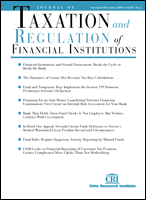Treasury Regulation 385: What it Means for Multinational Corporations
Author: William E. Wilcox.; Gabe Dickey.; Ryan Cahalan.; Tanner Bedsaul.
Source: Volume 31, Number 01, Fall 2017 , pp.23-33(11)

< previous article |next article > |return to table of contents
Abstract:
In 2016, Proposed and then Final Treasury Regulation Section 1.385 targeted multinational corporations to reduce their abilities to shift income from high-tax countries to low-tax countries. But the regulations could be potentially damaging to normal corporate operations, and could directly and indirectly impact financial institutions. While the vast majority of regulated financial companies are exempt from the regulations, captive insurance companies and captive REITs are not. The finalized regulations impact corporate treasury activities such as cash pooling and in-house banking, subjecting these once-acceptable practices to increased compliance costs. Multinational corporations may need to alter their corporate treasury practices if they cannot meet the new requirements or if they want to comply with the exceptions allowed under the regulations. However, these multinationals may now be exposed to new risks related to overreliance on third-party financial institutions and exposure to foreign currency risk. Furthermore, interested external users may experience difficulties associated with cash visibility, financial representation, and forecasting for multinational corporations. Thus, the 385 regulations may alter the way multinational corporations conduct activities with their related members.Keywords: Treas. Reg. Sec. 1.385, BEPS, cash pooling, income shifting, documentation requirements
Affiliations:
1: University of Northern Colorado; 2: University of Northern Colorado; 3: Florida Southern College; 4: Price Waterhouse Coopers LLP.